“Ho-ho-ho-ho-hoot! This is a rare sight. You are a fairy child, correct? What business might you have in this poisoned swamp? If you dare not venture further, I shall pass no judgment. It is better that you hurry back to town. This swamp you are in has lost its guardian deity. But it was destined to fade anyway.
Hoo-hoot…And that destiny is not solely limited to this swamp…
If you have the courage and determination to proceed in the face of destiny, then I shall teach you something useful. Before coming here, had you not seen any of the stone statues that bear close resemblance to me? I have placed those throughout the land to aid the one with the power to change the destiny of this land…
Wherever he may appear.”
~The Owl
The year is somewhere from 2007-2009. I am with my highschool classmates at a one-act play competition, sitting in the auditorium during some downtime. To pass the time, I pull out my laptop and boot up something a friend has given me for the first time, a program called “Project64,” which allows me to play N64 games. While I’ve never owned a console, I’ve owned some handheld Nintendo systems, and some of my favorite games have been the Zelda ones: the Oracle games, The Minish Cap, and the Game Boy Advance port of A Link to the Past. I am of course also familiar with The Wind Waker and the most recent Zelda game, Twilight Princess, even if I’ve only ever played the former, and only as a demo at Walmart. And of course, who hadn’t heard of Ocarina of Time? I’d even had the major plot twist of Sheik being Zelda spoiled for me accidentally by Super Smash Brothers Melee, when I chose a cool ninja character and was confused when he turned into some girl in a dress. But for whatever reason, Ocarina of Time was not one of the ROMs the folder my friend gave me contained.
So when I look through the list of games I have available to me, one stands out more than the others: The Legend of Zelda: Majora’s Mask.
This is how Majora’s Mask became my first 3D Zelda. I chose a game I knew very little about from a series I was already familiar with. I thought I knew what I was getting. What I got instead was a game like no other I had ever experienced. Something that completely changed my perspective of what a video game was, and more importantly, what a video game could be.
Before replaying it for The Great Zelda Playthrough, I would have named Majora’s Mask as my favorite Zelda game, and probably one of my top three games of all time. It means it was the game I was most excited to revisit, but also the game that I was most scared to, for one main reason: what if I was wrong? What if it didn’t hold up?
I could try to build up the suspense over this, but come on. It’s one of my all-time favorite games. Of course I’m still going to think it slaps. I’ve just started my replay and could’ve told you even before I started that it’d end up in my top three Zelda games. Instead, I’ll build up the thing that, at the time I’m writing this sentence, I still don’t know: will it surpass what I have as my current top Zelda game, Link’s Awakening? And if so, will the mysterious third game, which I have yet to name, manage to surpass it?
Let’s dive into Termina and find out.
The Story, Part 1: Leaving Neverland
Something I’ve noticed on this playthrough is that the first six Zelda games actually form three duologies, with the first game in each duology (Zelda 1, A Link to the Past, and Ocarina of Time) each focusing on a different boy named Link saving Princess Zelda and the land of Hyrule from Ganon(dorf). Ocarina of Time was an evolution of A Link to the Past, which was an evolution of the first game. However, the second game in each duology (Zelda II, Link’s Awakening, and Majora’s Mask) is a more unusual and experimental game that features the same Link from the previous game going through a more personal and emotional story, and usually one of growth. Nowhere is this more clear than Majora’s Mask, which is easily one of the most bizarre and emotionally taxing games in the series, and also probably the most direct and meaningful sequel in the entire series.
The game opens where Ocarina of Time left off, with Link traveling through the Lost Woods looking for Navi. He is ambushed by a Skull Kid wearing a strange mask, as well as his two fairy companions, Tatl and Tael. The Skull Kid steals his items and horse Epona, luring him into a cave and transforming him into a Deku Scrub. As he flees, Tatl gets left behind, and the two begin working together so she can return to her brother Tael.
The two follow the Skull Kid and Tael to a place called Termina, where a moon with an angry-looking face is slowly falling. Skull Kid sits atop the clock tower in Clock Town at the center of Termina, and at the end of three days, with the moon’s impact imminent, Link is able to confront him. It becomes clear that the titular mask is controlling the Skull Kid, and Tael begs Link and Tatl to stop him, asking them to save four giants to stop the moon. In the ensuing fight, Link recovers the Ocarina of Time and uses it to return to the moment he entered Termina, three days prior. From there, he and Tatl work to free the giants, though they only have those three days before the moon falls to make any progress, repeating them over and over until they’re able to succeed.

After Majora and the moon are destroyed, the Skull Kid, ultimately just a scared, lonely kid at heart, makes up with his friends in Tatl, Tael, and the giants before Link departs from Termina as its inhabitants celebrate the destruction of the moon.
This is the story of Majora’s Mask in broad strokes. However, the real story of Majora’s Mask is not Link’s attempts to save Termina, but his interactions with its people as they come to terms with the moon’s inevitable fall.
Majora’s Mask’s sidequests are the glue that holds the entire game together, as they’re centered around helping the people of Termina deal with their final regrets. Some are as simple as listening to Guru-Guru vent his regrets about his past or letting Grog see his baby chicks grow into roosters before the moon destroys the world.
However, the bulk of the story hinges on six different sidequests: the lead ups to the Woodfall, Snowhead, Great Bay, and Stone Tower Temples (all four required to beat the game), the Romani Ranch sidequests, and the Anju and Kafei sidequests.
The waters of the Southern Swamp, where Woodfall Temple is found, have been poisoned, and the Deku Princess has gone missing, having gone to Woodfall Temple to investigate. The Deku blame her monkey friend for her disappearance and have whipped themselves into a frenzy as they prepare for the monkey’s execution. After saving the Southern Swamp, rescuing the princess, and quelling the Deku’s anger, the Deku King’s butler tells Link that you remind him of his son, who recently went missing, implying that it was his death that fueled his transformation into a Deku Scrub.
In Snowhead, an unnatural winter is threatening to destroy the Gorons. Their last hope was in the Goron hero Darmani, who has recently died. Link speaks with his ghost and takes up his final mission, restoring spring to the Mountains and easing the worries of the fearful Gorons.
In Great Bay, the Zora band The Indigo-Go’s are preparing for a concert, but the lead singer has lost her voice after her eggs have gone missing–and the waters of the ocean have recently gotten murky and hot. Link heals the soul of the dying guitarist Mikau and takes up his final mission as well, saving Lulu’s eggs and cleansing Great Bay’s waters.
Finally, Link travels to Ikana Canyon, a long-dead kingdom where the inhabitants, even in death, have been unable to let go of their grudges or the war that plagued the nation. Link travels up the mysterious Stone Tower, ultimately falling into the sky above the temple found there to defeat the evil there and release the curse keeping the inhabitants from moving on.
There’s a lot I could say about these four segments of the game, but if I said everything I wanted to about them, I’d never finish this writeup. They’re all thematically important (with Ikana Canyon, one I expected to write off as being unimportant actually being what I found to be thematically strongest). Many have claimed that the five main areas of the game represent the five different stages of grief, and while I personally don’t think they line up as well as the theory states, it definitely makes sense with the ideas of the game, as it’s pretty clearly about loss, grief, trauma, and death.
So instead of going super in-depth and looking at how each of these locations are impacted by the Skull Kid, Majora, and the Moon, I’m going to gloss over the story told across the four major dungeons to focus on the real meat of Majora’s Mask, which can be found in the sidequests in Clock Town and Romani Ranch.
Romani Ranch is home to two sisters whose parents have passed on: the older sister Cremia and her younger sister Romani, named for the ranch. Cremia is under a lot of stress, single-handedly running the farm, which has been under attack from vandals and bandits and has recently been cut off from the outside world. In addition, her best friend is about to marry the man she likes (information gleaned from a few secret conversations), and the moon is falling, threatening to crush everything beneath it.
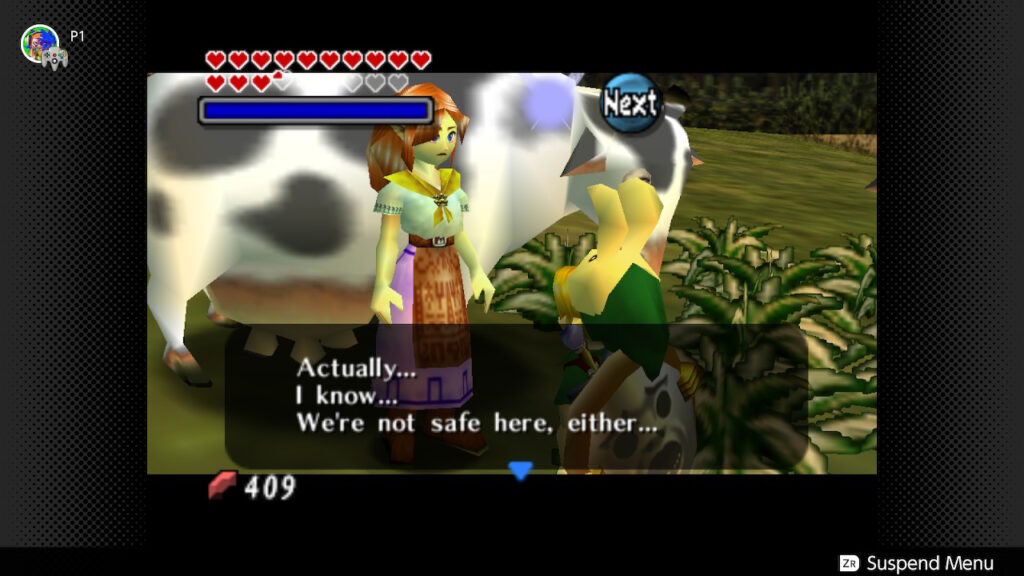

Romani, meanwhile, is cheerfully oblivious, but has her own problems: namely that aliens who are just referred to as “Them” are going to come to abduct their cows (yes, really), and her sister doesn’t believe her. Instead, she enlists Link’s help to fend off these otherworldly invaders.
If you help Romani save the ranch, Cremia will be able to deliver milk to town, and invites Link along on a wagon ride. She doesn’t have any real request for Link. She just wants some company, since Romani has to stay home to watch the ranch. This is a moment I’m not entirely sure how to read. Does she anticipate an attack on the wagon and wants Romani home safe? Does she anticipate an attack on the ranch and wants Romani there to defend it? Does she want company to talk to someone about things she doesn’t feel comfortable talking to her sister about? It’s not entirely clear, especially since Cremia is a very guarded character. For example, you learn about her attraction to Kafei from her sister Romani rather than her. When she speaks about his impending wedding, she only mentions her friend Anju, not him.
On the way to town, Cremia is attacked by brothers from a rival ranch. If Link successfully defends the wagon, she’ll thank you, giving you the Romani Mask, a cow-shaped mask that gives you admittance to the milk bar Latte after hours. She says “by doing one good deed, a child becomes an adult,” further elaborating that it’s a mask only given to a limited number of adult customers, and by giving it to Link, she’s acknowledging him as an adult.
Latte’s signature drink is the Chateau Romani, a vintage milk drink that seems to have inebriating effects. If Link visits the ranch on the final evening, Cremia will tell Romani that she’s giving her a bottle of Chateau Romani to drink that night. While many have taken this as an indication that she’s trying to get her sister drunk to numb her to the end of the world, I’ve always read the scene as Cremia acknowledging Romani as an adult, especially since she says that she plans on making her a mask as well. And based on how proud and enthusiastic Cremia seems watching Romani show off her bow skills in the credits, especially given how dour she usually is, I like to think the acknowledgement was genuine.
The Romani Ranch sidequests are unavailable until after you’ve beaten the second dungeon, and proceeding to the final two dungeons requires obtaining Epona from the ranch. There’s an opportunity to upgrade your sword after completing the second dungeon that leaves you without it for the first two days, and the Romani Ranch sidequests on those days just so happen to all be based around horseback riding and archery. The game practically thrusts this storyline in your face right at the midpoint of the game. After observations of the coming-of-age themes in previous Zelda games, this sidequest and the idea of “one good deed” linked to adulthood stood out to me. In a game like Majora’s Mask, which focuses so heavily on loss and grief, but also on helping people with their little problems, this line stood out to me as thematically key to the game.
The Link in Majora’s Mask is the same one as in Ocarina of Time. He’s a traumatized child who has lost his home and his best friend. He has, in keeping with the series’ Peter Pan allusions, been kicked out of Neverland. And that fills him with a great sense of loss. The idea of loss is also ever present in the game. So many characters have lost someone important to them, and if the moon falls, they’ll all lose their lives as well. But by pressing forward despite the pain he feels, Link is able to heal the pain of others. And in the process, he’s able to heal some of his own pain as well.
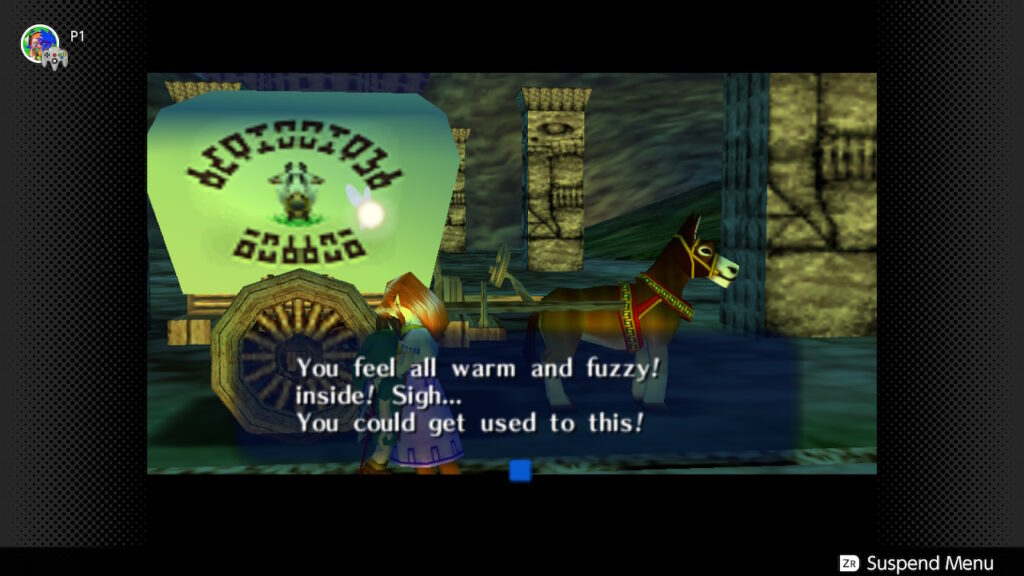
Link’s Awakening is the story of Link leaving Neverland, of waking up from an idyllic, naive dream. But Majora’s Mask is the story of Link leaving Neverland by breaking free from a nightmare: a never-ending cyclical one that threatens to crush him. But he fights. He struggles. And in the end, I think it’s not just Termina, but the grief and despair of his own loss that he’s finally able to wake up from.
The Story, Part 2: Back to the Center
Okay. It’s time to talk about the Anju and Kafei storyline. The one everyone thinks of when they talk about the game. The one big enough to get its own subsection. Because while this sidequest is centered around Anju and Kafei, it involves almost everyone in Clock Town.
Anju and Kafei’s storyline is the one that, whether you know it or not, is the first one you’re introduced to. Clock Town is set up in such a way that the first thing that will draw your eye is a boy with blue hair wearing a mask. He drops off a letter in a postbox and immediately runs away, retreating into a room that locks behind him. You cannot speak to him. And unlike other characters, who share models with characters from Ocarina of Time, he has a unique model. Everything about this boy is designed to draw your attention.
The first step in this sidequest is to obtain Kafei’s Mask, by talking to his mother, Madame Aroma. This is the first mask in the game you’re able to obtain (Deku Mask excluded), as it can be obtained in Clock Town on the first morning with no strings attached. While talking to her, you’ll likely encounter Toto and Gorman, two managers disappointed their band and troupe respectively will be unable to perform at the Carnival of Time. You’ll also likely encounter her husband, Mayor Dotour, who is stuck in a tense meeting between the soldiers and carpenters regarding whether to evacuate the town or continue to hold the carnival.
By talking to a few characters wearing Kafei’s mask, you may gain a bit of information, including learning that Anju, who works at the Stock Pot Inn, is also looking for him. Or, you can connect that the Bombers, the children around town dedicated to helping others, have noticed him around the Laundry Pool, the same place where that masked boy (whose hair is coincidentally the same color as Kafei’s) dropped a letter in the postbox. Maybe you can find more information by following the Postman.
All the characters in the game are on a schedule, but none more so than the Postman, who is in near constant motion and who asks that you not talk to him while he’s on the job so his schedule won’t be disrupted. If you follow him through his strict schedule, you’ll see him pick up the letter the blue-haired boy dropped off in the morning, then deliver it to Anju in the afternoon. Incidentally, if you speak to the Postman wearing Kafei’s Mask, he’ll tell you that he doesn’t know where he is, and if he did, it would be a secret. Curious. If you speak to Anju wearing Kafei’s Mask after this, she’ll ask to meet you that evening. Around that time, she may also mistakenly check you into a reserved room next to the one her family stays in.
That evening, Anju tells you that Kafei is her fiance, who she’s set to marry on the day of the Carnival. Despite Kafei being missing, she’s received a letter from him. She asks you to mail a letter in return, and find where it’s delivered (which again requires you following the Postman), stating that she’s too afraid to go herself, as she fears she might be the reason he disappeared.
Shortly afterwards, in another part of town, a thief named Sakon attacks an old woman from the Bomb Shop and steals her merchandise. This is a small moment, but an important one. We’ll be coming back to it.
When you follow the Postman the next day, you’ll see him deliver a letter to the masked boy at the Laundry Pool. He recognizes you from your green clothes and reveals that he is, in fact (to I’m sure no one’s surprise), Kafei, who has been cursed by the Skull Kid with the appearance of a child. He explains that, despite his appearance, he still wants to see Anju again. However, Sakon has stolen the traditional engagement mask he made, and he’s too ashamed to face her without the mask.
He further explains that he knows the shady man who runs the Curiosity Shop, a place that buys and sells miscellaneous items with no questions asked regarding how they’re obtained. Sakon is one of his regular customers, so he plans on watching the Curiosity Shop through a secret spyhole in his back room. He’s sure Sakon will show up. In the meantime, he asks you to deliver his pendant to Anju, along with a promise that he’ll come back to marry her.
However, as the second night falls, a shift in attitude has started to take over all of Termina, as the reality of the moon’s impending collision sinks in. Anju’s mother tells her that tomorrow evening, they’ll be going to Romani Ranch. That it’s foolish to wait for Kafei. That maybe Kafei has run off and is already there with Cremia. And if he is, is that so big of a deal? Cremia’s having a hard time running the ranch. If Kafei is with her, she has a partner to help her and business support from the Mayor’s family. If Kafei really has run off with her, she should be happy for her friends, because she couldn’t be happy with a man like that, much like she wasn’t happy after her own husband’s disappearance. And why would he come back to a town about to be crushed under the moon? Anju is forced to make a difficult choice: does she stay and wait for a man who may not come? Or will she leave and abandon him? Her decision depends entirely on whether or not you give her the pendant Kafei gives you, reassuring her he’s out there, he still loves her, and he’s going to at least try to make it back to her.
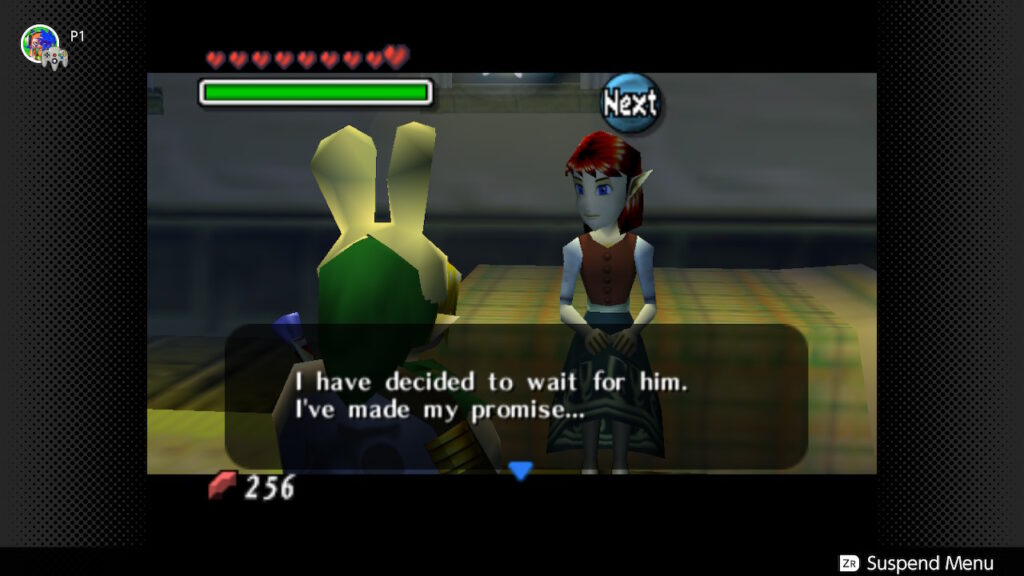
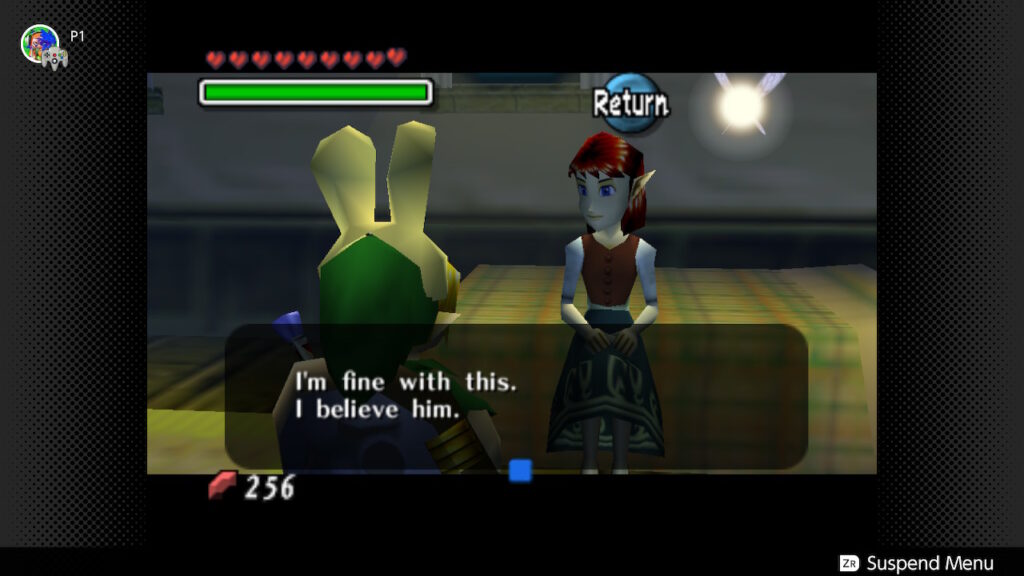
This much of the quest is easy to do. It can all be done on the very first cycle after you obtain the Song of Healing. What happens next depends on your actions as the player.
Kafei’s plan hinges entirely on Sakon showing up at the Curiosity Shop, and he’ll only show up if he has goods to sell, i.e., the merchandise stolen from the old woman from the Bomb Shop. If you saved that old woman, Sakon will have nothing to sell and Kafei won’t be able to follow him back to his hideout. But even if you do save her, this is the first place you’ll hit a roadblock. See, it’s pretty easy to convince Anju to stay and wait for Kafei. But helping Kafei recover his mask from Sakon so he can face Anju is a little more difficult.

Sakon’s hideout is in the upper part of Ikana Canyon, and you can’t reach that until you have the hookshot, which is obtained from the Pirate Fortress in Great Bay, which can’t be reached until you have Epona, who can’t be obtained until you’ve beaten Snowhead Temple and can buy powder kegs, which can’t be accessed until you’ve beaten Woodfall Temple and obtained the bow. But even if you have the hookshot, you can’t access that part of Ikana Canyon until you’ve also obtained the Garo Mask from the Gorman Brothers, and you probably won’t know they have that mask until you’ve seen them wearing it while attacking Cremia’s wagon, which you won’t be able to do until you’ve defended Romani Ranch from “Them,” and honestly at that point you were probably doing the Romani Ranch sidequests anyway because up until that point you’ve only been able to access the ranch on the third day after they’ve lost all their cows, Romani is in a catatonic state, and Cremia is absolutely devastated, so why wouldn’t you try to do everything to help them now that you can (especially since you’re probably upgrading your sword anyway)? And in addition to all that, if you do save the Bomb Shop lady, the Curiosity Shop owner doesn’t have her Bomb Bag to sell and instead has something called the All Night Mask, a mask that costs 500 Rupees, which is more than you can carry unless you have the largest wallet, which you can only obtain by beating the Oceanside Spider House (and only on the first day) after you get the hookshot, which is, again, one of the items you need to finally reunite Anju and Kafei. Oh, and of course, you get the hookshot in the middle of saving Lulu’s eggs, and you’re probably not going to want to just abandon that sidequest partway through since you’d just have to do the whole quest over again, and at that point Great Bay Temple is right there, and while you can reach the lower part of Ikana Canyon and do a lot there right after you get Epona, you can’t reach the warp point until you have the Ice Arrows (which you get from Great Bay Temple), and having to ride Epona to Ikana Canyon every single time you want to go there in a game about time management gets super tedious so you may as well just complete Great Bay Temple while you’re at it for those Ice Arrows that will give you access to the warp point, and also the rest of Ikana Canyon. And hey, as long as you’re there, you may as well make some progress on Ikana’s storylines as well!
My point with that very long and deranged paragraph is that the very moment you’re able to complete the quest, the game also opens up immensely. Unlike the Romani Ranch sidequests, which the game practically thrusts into your face, Majora’s Mask does everything to draw you away from the Anju and Kafei sidequest the very moment you’re able to complete it. What’s more, there are still a LOT of ways the sidequest can go wrong. Maybe you save the Bomb Shop woman so that Kafei doesn’t have a lead. Maybe you don’t deliver the pendant to Anju, meaning she’s not confident enough he’ll return to remain and instead goes to Romani Ranch with her family, regretting her decision all the while. Maybe you do what I accidentally did on one attempt and run into Sakon as he’s heading towards his hideout, scaring him off and leaving Kafei waiting for a man who will never appear (this was the most devastating moment in my entire playthrough). Or maybe, even after doing everything right, you screw up in Sakon’s hideout, right at the eleventh hour, and Kafei loses his mask. There are so many ways for this sidequest to go wrong, and so many other things that you can prioritize instead. It’s easy to want to help Anju and Kafei. But it’s hard to help them. There’s just no time, and there are so many other people to help.
But every time you reset time, the first thing you see is Kafei dropping that letter in the mailbox. Every trip back to Clock Town, you’re almost guaranteed to encounter someone who’s linked to Anju or Kafei in one way or another. Everything is there to remind you that the sidequest is still there, to say “hey…maybe this time you can reunite them.”
If everything is done correctly, Kafei will see Sakon and pursue him to Ikana Canyon, camping outside the thief’s hideout and waiting for him to appear. The owner of the Curiosity Shop will inform you of this on the afternoon of the final day, leaving you the Keaton Mask Kafei’s been wearing the entire game, and giving you Priority Mail for his mother, Madame Aroma.
Once night of the final day falls, you’ll have to dedicate almost the rest of the cycle to retrieving the engagement mask with Kafei. Since you’ll scare Sakon off if he sees you, the game asks you to spend an extended period of time sitting and waiting with Kafei for him to appear. Then, once you enter his hideout and trigger a trap that sends the mask down a conveyor belt, a series first happens: you control a character other than Link. In this segment, you alternate between puzzle segments with Kafei and combat segments with Link. If you’re able to successfully make it through Sakon’s gauntlet and retrieve Kafei’s mask, he’ll rush home–but not before the cycle’s clock is set to the final hours, to emphasize just how much this has become a race against the clock as the moon’s excruciatingly slow fall is nearing its conclusion.

In the final moments, there’s not much left to do in Clock Town apart from waiting. But this is where you’re finally able to help the Postman and Madame Aroma, two people who were essential to the early part of the sidequest. You can either deliver Kafei’s priority mail to Madame Aroma yourself (if you’ve obtained Romani’s Mask, that is), or you can give it to the Postman, the man who has spent the entire game bound so strictly by his schedule, by time itself, lamenting that the schedule doesn’t say he can flee. But when you give him the Priority Mail, when you give him the opportunity to interact with Madame Aroma one more time and have her order him to flee, he is finally freed from that burden. He gives you his hat and, for the only time in the game, joyfully prances (rather than running) out of Clock Town.
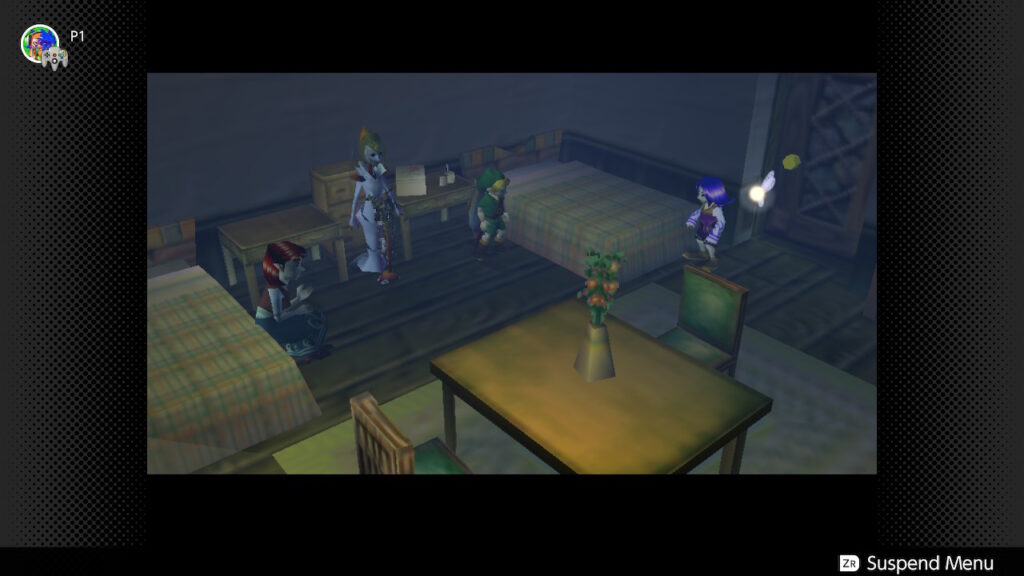
In the tense, final moments, presumably after multiple attempts and failures on the part of the player, Anju and Kafei finally reunite, exchanging vows just before sun-up of the morning they promised to be married, and stating that they’ll greet the morning together, giving you the Couple’s Mask as thanks.
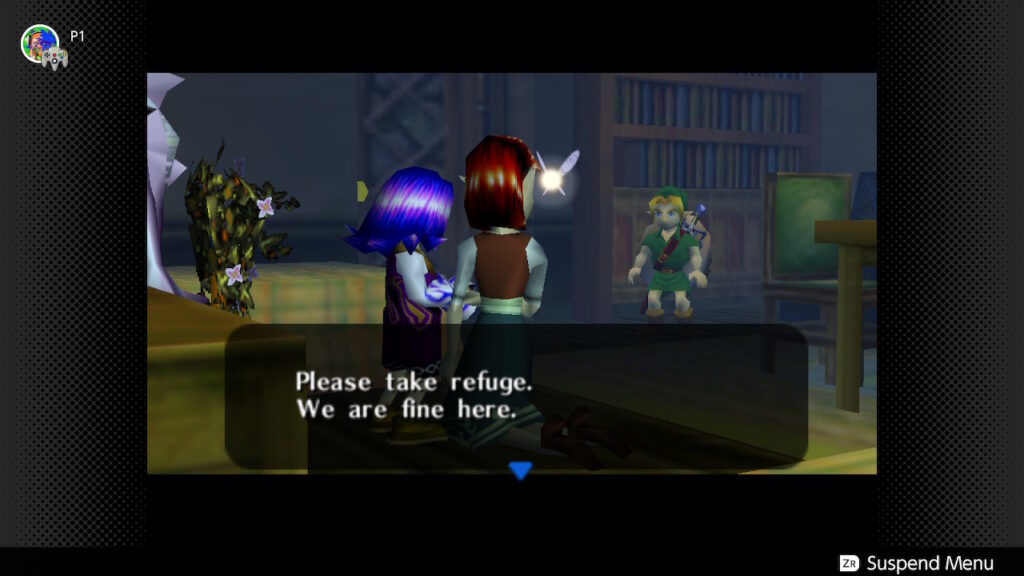
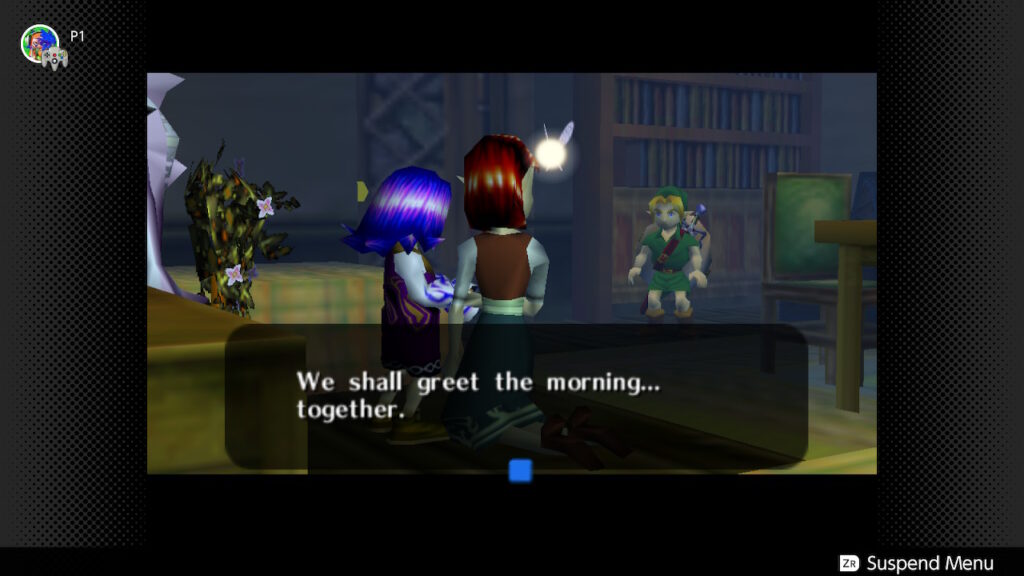
This sounds like it’s where the story of Anju and Kafei ends, but it’s not. Because the Couple’s Mask only has one purpose: it stops the fighting in the Mayor’s office as everyone remembers that they have loved ones they want to spend just a little more time with, and that squabbling over whether to evacuate Clock Town or not is pointless. Everyone can decide that on their own.
This seems like a footnote, but in doing this, it brings the soldiers, the carpenters, and Mayor Dotour into Anju and Kafei’s storyline. And with that, nearly every single person in Clock Town is linked to Anju and Kafei in one way or another. Madame Aroma, who sends you on the quest. The Postman, who conveys their letters. The owners of the Bomb Shop, who have their wares stolen by Sakon, who sells them to owner of the Curiosity Shop, who’s a longtime friend of Kafei’s. Anju’s mother and grandmother, who worry she’s making the wrong choice. Cremia, who cares about both of them and who’s willing to take Anju’s family in as the moon falls. The most notable exception apart from the business owners is the Gorman troupe (with Gorman and his brothers tied more to the Romani Ranch storyline), but even then, they’re staying at the Stock Pot Inn that Anju’s family owns.
This storyline is the most difficult to complete, because there are so many ways to screw it up. But it’s rewarding, because it’s connected to everyone in Clock Town, which is the heart of the game.
There are generally considered to be four dungeons in Majora’s Mask, but Clock Town is functionally the fifth. It’s a different type of dungeon, but it’s probably not until the end of the game that you’ll resolve all its storylines. Everything starts there. Everything ends there. Everything about the quest and the game as a whole is designed to bring you back to that center.
The Legacy
Majora’s Mask is, compared to the rest of the Zelda series, a real odd duck. The thing that struck me most about the game is how drastic a departure it is from the rest of the franchise. It doesn’t feel like a Zelda game, and despite many assets being recycled from Ocarina of Time, it often doesn’t look like one either. The series has no consistent artstyle, preferring to switch it up with every new game, but despite how different they are, they still all usually feel like Zelda. Majora’s Mask? It feels like it was developed as an entirely different game and was given a coat of Zelda paint halfway through.
This isn’t the case, though. Majora’s Mask was always intended to be a Zelda game, with the guiding principle of the development being “use the Ocarina of Time engine to make a sequel as quickly as possible.” I’m a firm believer that restrictions breed innovations, and Majora’s Mask is a fantastic example of that. It took the familiar trappings of Ocarina of Time and made them feel unfamiliar by transposing them into an entirely new world. Termina, simply put, does not feel like Hyrule. Sure, there have been games set partially or entirely outside of Hyrule before, but everything about the presentation of Termina feels alien. From the music to the color palette to the gameplay, it’s not quite like the Zelda games that came before, and since most of the elements Majora’s Mask added to the series never come back up, it’s not quite like the Zelda games that came after. As a result, it hasn’t left its fingerprints on the series like a lot of other games have.
At least, not in an obvious way.
What Majora’s Mask lacks in direct influence, it makes up for by adding a new layer of mystery to the series. What and where exactly is Termina? Who or what is Majora? The game doesn’t offer clear answers, and Twilight Princess and A Link Between Worlds subtly imply that the Twili or the Masked Followers have some sort of ties to either Termina or Majora.
Majora’s Mask may not have added a lot to Zelda’s actual canon, but it lurks, bright orange eyes watching ever-presently from the shadows of what hasn’t been codified. The mystery surrounding Majora’s Mask is probably the leading reason for the direction the lore has taken, with open-ended questions that are given multiple interpretations, always dancing around and hinting at some sort of lore, but never in a way that makes sense. It’s one of the things I’ve grown to love most about the series, and I think Majora’s Mask is a big part of why the series went in that direction.
I’d also note that Majora’s Mask’s more technologically advanced clockpunk elements have had some inspiration on the series, with future games more willing to bring in anachronistic elements. The pictograph box and Tingle have been recurring characters and items that originated in Majora’s Mask. And, of course, while Ocarina of Time codified the Zelda formula, its sequel Majora’s Mask broke from it entirely, giving the series the freedom to reinterpret itself, to make sure every game moving forward could have a distinct, unique feel. Without a game like Majora’s Mask to challenge the idea of what a Zelda game is, I’m not sure you could have a game like The Wind Waker.
So while Majora’s Mask’s impact on the franchise as a whole is low, it’s still an integral part of the series’ DNA. They may be recessive genes, but they’re there.
My Playthrough, Part 1
As I mentioned in the introduction, my first time through Majora’s Mask was on an emulator rather than a console, and I’ve never properly replayed it since then. I’ve played the opening on the Wii’s Virtual Console, and I’ve replayed a chunk of the 3DS remake. However, unlike Ocarina of Time’s 3DS remake, which was overall very faithful to the original, Majora’s Mask’s made some substantial changes. While there were some useful quality of life changes, I felt that many of them ended up detracting from or missing the point of the original game (see this fantastic video by Nerrel breaking down some of the changes and why they don’t work; I wholeheartedly agree with most of it). It didn’t feel like the 3DS remake was the “definitive version” like Ocarina of Time 3D was, so I didn’t want to experience that version for my playthrough.
Around the time I started replaying Ocarina of Time, the Nintendo Switch Online program began adding the ability to play N64 games, including (after a brief delay) Majora’s Mask. They also produced a wireless N64 controller that connected to the Switch. This meant that I would be easily able to play the game in as close to the original format as I could without purchasing an N64, Majora’s Mask game cartridge, controller, and Expand Dong N64 Expansion Pak. I was overjoyed that I’d be able to experience one of my favorite games with the controller it was designed to be played with.
I set out with several goals and rules in mind for this playthrough. First, I was allowed to take advantage of the Switch Online’s save states in order to pause my progress so I wouldn’t need to find an owl statue or reset the cycle. I am an adult with obligations and limited time, after all. However, I was NOT allowed to use save states to keep replaying a section. If I messed something up, I’d need to reset the cycle and do it all again. The exception would be if I was particularly struggling with a minigame, especially because the aiming controls felt a bit clunky (in the end I only needed to do this for two minigames, but boy did I need to do it for those two minigames). This allowance was made because of my second playthrough goal: 100% completion. And my final goal was to do it all without consulting a guide.
My final goal eventually fell by the wayside, precisely because of the 100% completion goal. Sure, I could stumble through the game trying to find every bottle or heart piece, and take months to complete it. Or, I could look up the odd thing here and there to make each cycle I played through feel fulfilling and rewarding.
I also found that making every cycle feel fulfilling often led to me repeating sidequests I’d already finished and received the rewards for. The main quest and temple for each area will usually take around a full cycle to complete, meaning that sidequests and exploration are often best done in their own cycles. Because certain events only happen at certain times, that means there’s a lot of extra time to kill. The easy way of doing this is to play the Song of Double Time or dance with the scarecrow to jump ahead 12 in-game hours. But I almost never did, and I’d like to take a bit of time to explain why.
Beating Snowhead Temple allows you to both forge the Gilded Sword–which requires spending the first two days swordless–and access Romani Ranch’s sidequests, which are conveniently all focused on archery and horseback riding. As such, it’s most efficient to tackle the Romani Ranch storyline while your sword is in the forge, since you’ll need to get Epona from there to access Great Bay and Ikana Canyon anyway.
The reward for helping Romani and saving the ranch from “Them” is a bottle, but it also allows you to do Cremia’s quest. In this quest, you ride with her as she takes a carriage filled with milk into town and rambles on about her worries for the farm, about what’s going on in town, and about the moon that’s growing ever closer before you protect the wagon from a pair of bandits (who are obviously the Gorman brothers) set on destroying her wares. If you defend the wagon successfully, she’ll thank you with a mask that allows you into Latte, a milk bar exclusive for adults, telling you that a child becomes an adult by doing one good deed. Inside Latte, which you couldn’t access before, you’re able to do the quests for Toto and Gorman, who are given two separate entries in the Bombers’ Notebook. However, you help the two of them at the same time and only receive one reward: a mask whose sole purpose is keeping the Gorman brothers from attacking the wagon. That’s right, your reward for defending the wagon is something that has no utility apart from defending the wagon again.
To me, this coupled with Cremia’s speech about “one good deed” is a deliberate message to the player: you’re supposed to replay these sidequests. You’re supposed to do them again and again if you have the chance, because helping people is its own reward. That maturity is about having both the strength and the kindness to help people with their problems, even if there’s no reward or it won’t solve the problem permanently.
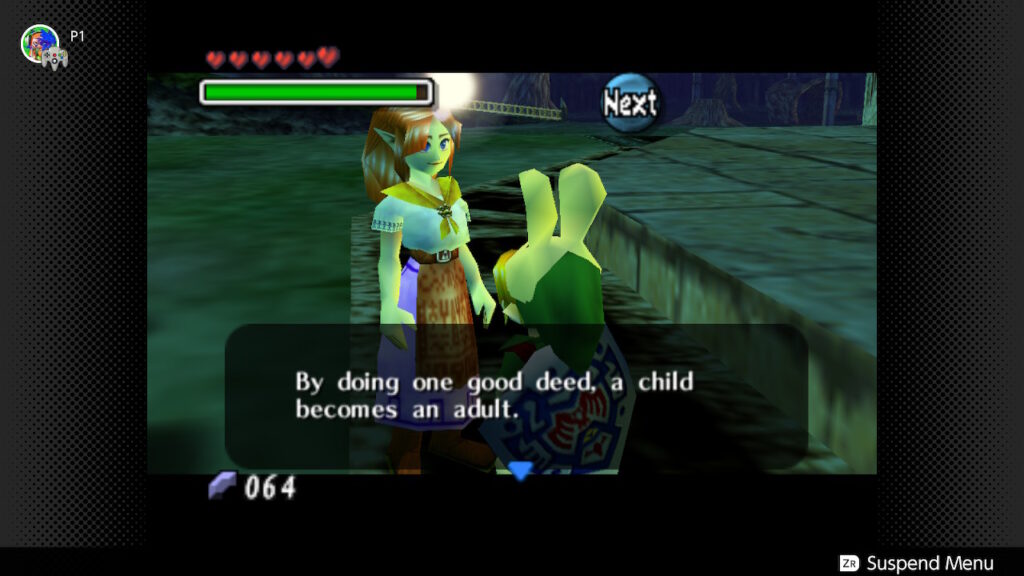

This is why I found so much more joy in redoing these sidequests instead of skipping over them, about taking the time and doing everything I could to bring some measure of comfort into the lives of these fictional characters. It didn’t matter that I couldn’t complete the Anju and Kafei sidequest yet, or that saving Romani Ranch this time didn’t mean it would stay saved in other cycles. If I had the time to do something, I would do it, because it felt right.
When I finally managed to get everything in the game, with the exception of the final Heart Pieces on the moon, I reset time once more, deciding to take everything I’d learned, everything I’d practiced, every tool I had at my disposal to make this final cycle count.
My Playthrough, Part 2: The Final Cycle – In the Face of Destiny
I started by withdrawing as many rupees from the bank as I could. I bought a Powder Keg, opened the road to Romani Ranch, let Grog see his chickens grow up, promised to help Romani defend the ranch (easily beating her practice record in the process), went to the Southern Swamp to heal Koume, beat Odolwa to cleanse the swamp, rescued the princess and saved the monkey, then went to Snowhead to defeat Goht and bring spring back to the mountains. All this by 10 AM. I went back to Clock Town to quell the arguing in the Mayor’s office, checked into the Stock Pot Inn (sorry, Goron Link), saw the postman deliver Kafei’s letter to Anju and promised to meet her that night. From there, I had a lot of time before there were any major events, so I went to Great Bay and rescued all four of Lulu’s eggs in the pirate fortress, dropping them in the tank right as night of the first day fell.
I then went to Pinnacle Rock to clear out the Deep Pythons, reunite the seahorses, and rescue Lulu’s final three eggs. I went back to Clock Town, listened to Guru-Guru vent, taught the Rosa sister’s Kamero’s dance, met with Anju and dropped her letter to Kafei off, stopped by the Latte milk bar to perform Ballad of the Wind Fish for Toto and Gorman, and picked up a bottle of Chateau Romani for infinite magic power. I had just enough time to heal Kamero’s soul right before saving Romani Ranch from Them (by this point, I’d gotten so good at the quest that I got lazy and almost failed it at one point). With the last few moments of the day, I went back to Great Bay to have a jam session with Japas and teach the song to Evan.
This is when Dawn of the Second Day broke. While I was still in Great Bay, I defeated Gyorg to clear up the murky seas, followed by band practice with the Indigo-gos to finish up all the quests in Great Bay. With the swamp, mountains, and ocean taken care of, that just left Ikana Canyon. I conveyed Flat’s sorrow to Sharp (realizing in the process I’d missed my chance to speak to Flat himself), healed Pamela’s father from his Gibdo affliction, defeated King Igos du Ikana and his lackeys, and defeated Twinmold to allow the souls of the dead in Ikana to move on. This was just in time to talk to Kafei and deliver his pendant to Anju.
This is when my final cycle started to become really interesting. Because at this point…I had already done pretty much everything major I could think to do, and I still wasn’t even to the Night of the Second Day. I was way ahead of schedule, which meant I’d have a lot of downtime. It raised an important question: over the next day and a half, how much could I actually do?
I started doing things I didn’t think I would have time for, smaller tasks that I thought would either be too time-consuming or two trivial. I gave a potion to Shiro, the invisible soldier whose Stone Mask had helped me make short work of the Pirate’s Fortress. He deserved to be repaid for that kindness. I gathered the frogs, a somewhat time-consuming process that involves delving into dungeons to refight two minibosses, just so they could be reunited and sing together. I’m sure it meant a lot to them. I played with the Bombers, officially being christened as a member of the Bombers Secret Society of Justice. After all, these were kids who were dedicated to helping others and who would stick around until the Moon fell. I could spare some time to play hide-and-seek with them and let them know I was dedicating myself to doing good for others. All this in between juggling the Anju and Kafei and Romani Ranch sidequests. I was doing so much, and I still had so much time. Every failure, every time I’d gotten locked out of a quest I thought I’d memorized, every time I’d taken a wrong turn in one of the Temples and cost myself time…I remembered them. I’d pushed myself to improve, to complete tasks faster and more accurately.
I started to wonder where my limits would be. Could I take on the miniboss rush in Ikana Canyon to help their souls depart? Could I get all the Business Scrubs better land deeds? Could I lift the curses of the Swamp and Oceanside Spider Houses, restoring the humanity of one man and providing shelter for another? Could I somehow manage to save all the stray fairies, essentially going through the entirety of four dungeons in a single cycle? Would that even be possible?
“By doing one good deed, a child becomes an adult.”
One good deed. One act of kindness. According to Cremia, that’s all it takes.
How many good deeds could I do?
Unfortunately, at this point, I started to hit my limit. I managed to complete the Swamp Spider House and cure the man who’d given me the Mask of Truth, and that’s about all I had time for, since once night of the final day hit, I’d be forced to spend all of it helping Kafei get the Sun Mask back. I couldn’t save the stray fairies. I couldn’t clear the Oceanside Spider House. I couldn’t do the miniboss rush. But I felt like, if I were to play the game enough, become intimately familiar enough with Termina to play as efficiently as possible, maybe I’d be able to. Maybe one day I would.
So I returned to Clock Town for the final hours.
The final six hours are always the starkest part of the game, because while you can feel time slipping away more acutely with every second, it also feels like time slows down. When doing the Anju and Kafei sidequest, which concludes with less than two hours left on the clock, you have to spend an agonizingly long time waiting for Kafei. Despite that, almost everyone in town has left and there’s not a lot you can do while waiting other than talk to the people in town and experience their final moments. The proud swordmaster, cowering in his back room. The head carpenter Mutoh, raging at the moon and daring it to fall. The soldiers, urging you to flee but remaining at attention themselves. And of course, the Postman, wanting to flee but unable to because it wasn’t written on the schedule.

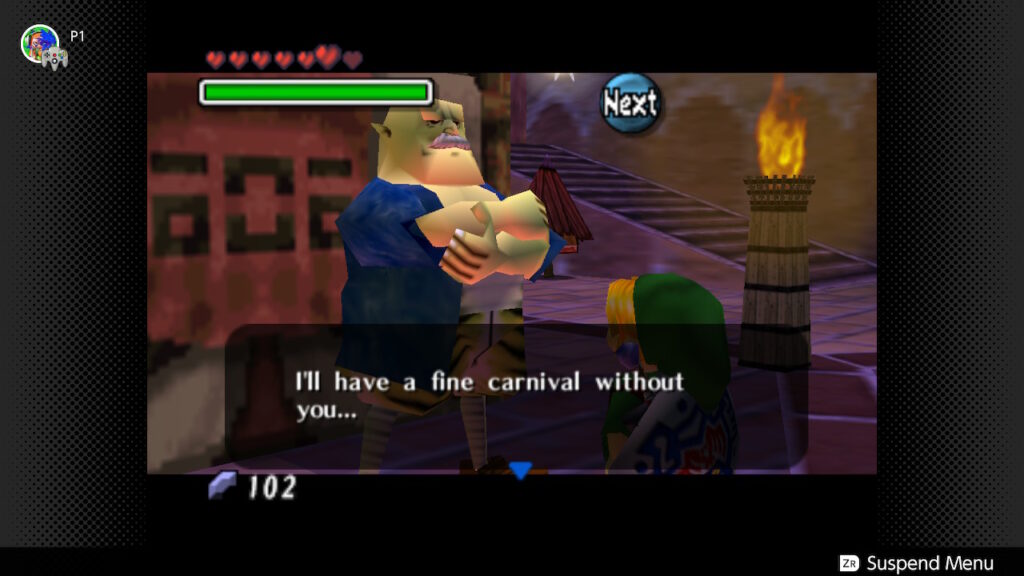

If there was one sidequest it felt right to put in the final hours alongside the Anju and Kafei storyline, it’s the Postman’s final delivery. There’s something beautiful about watching him take the time to change, to dress up in his uniform before he makes the delivery. You can tell it’s important to him, and it’s hard not to want to spend his entire journey to Latte following him, despite how slowly he moves.
Likewise, it’s hard to know what feels more impactful, staying with Anju as she waits for Kafei to show up, or following Kafei as he rushes to Anju, moving slowly once he enters the Stock Pot Inn, slowly increasing pace until he’s running up the stairs, slowing once more as he reaches the top, almost hesitating before he opens the door. She doesn’t know if he’ll show up. He doesn’t know if she’ll be there. But they both believe.
It’s hard to not want to reward that faith by making sure this isn’t where their story ends.
With my final moments, I entered the Clock Tower once more to speak to the Happy Mask Salesman. He had a comment about every mask I’d collected, reminding me once more of either what I had gone through to obtain the mask, why it had been given to me, or what the mask represented. The Bremen Mask, which showed I had the qualities of a leader. The Keaton Mask, which carried quite a lot of nostalgia. The Blast Mask, which was filled with feelings of the Bomb Shop Lady’s gratitude. There was some type of meaning to every single mask (he even has a comment about the Giant’s Mask, which it’s impossible to wear while speaking to him without cheat codes), some sort of story or purpose attached to it.
I’m glad I did this, because the final segment of the game takes place inside The Moon, in a giant meadow where children wearing the masks of the game’s bosses are playing. The children ask you to give up your masks to them, each asking for more. It’s a sequence that asks you how much you value each of your masks, with many masks easy to give up (when am I going to use the Mask of Scents or Kamaro’s Mask again?), and many, like the Couple’s Mask I’d worked so hard for, much harder to part with. For me, the final four I gave up were the Mask of Truth (which had given me plenty of little story tidbits and helpful guides), Romani’s Mask (which I felt a lot of thematic attachment to this playthrough), Kafei’s Mask (the first mask I received, and the one I felt most represented his and Anju’s storyline), and finally the Bunny Hood, which had been bound to one of my C-buttons almost the entire time and that I had gotten a great deal of use from.
By giving up all these masks, all the representations of the good I had done for the people of Termina, I was rewarded with the Fierce Deity Mask, using it to easily and quite anticlimactically thrash Majora.
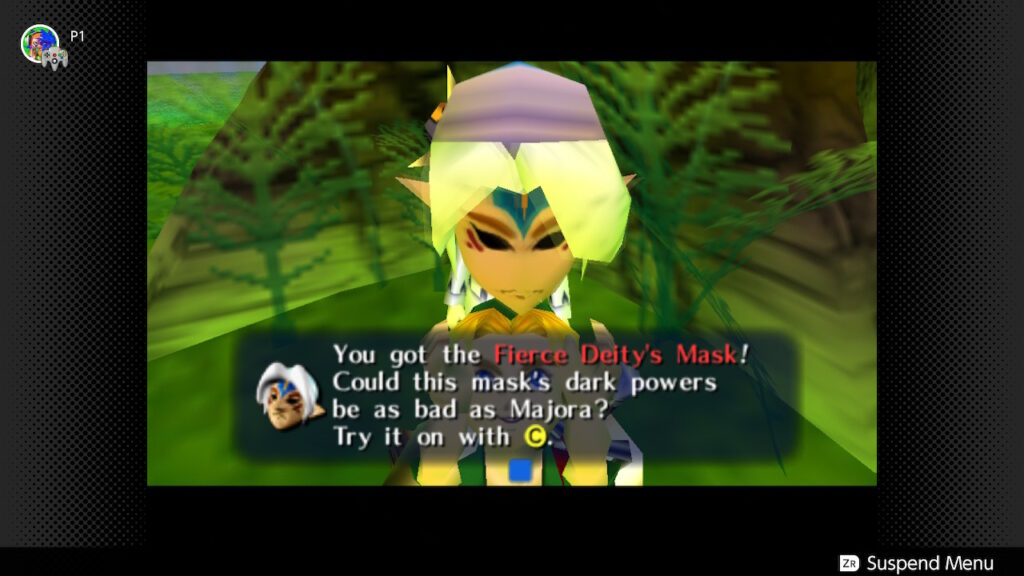
By doing one good deed, a child becomes an adult. But what happens if you do as many good deeds as possible? You become something more. Every Mask, every Heart Piece, every token of gratitude I’d received through the game coalesced in the form of the Fierce Deity Mask. I channeled all the power their thanks had given me. All the darkness of Majora, all the pain and grief and dread it had caused couldn’t stand up to all the good I had done. Trying to do as much as I could in the final cycle had made me intimately familiar with the entirety of Termina, and I fought with the strength of every single one of its inhabitants, fueled by their faith, their dreams, their gratitude and happiness.
The world is dark. It is bleak. It’s hopeless. But you have the power to make it a little brighter, a little better. And fighting, struggling for that even in the face of destiny, no matter how sisyphean that is? It’s still worth it.
That’s the mentality I approached this playthrough with: make every cycle count. Especially the last one. And I appreciated it a whole lot more because of it.
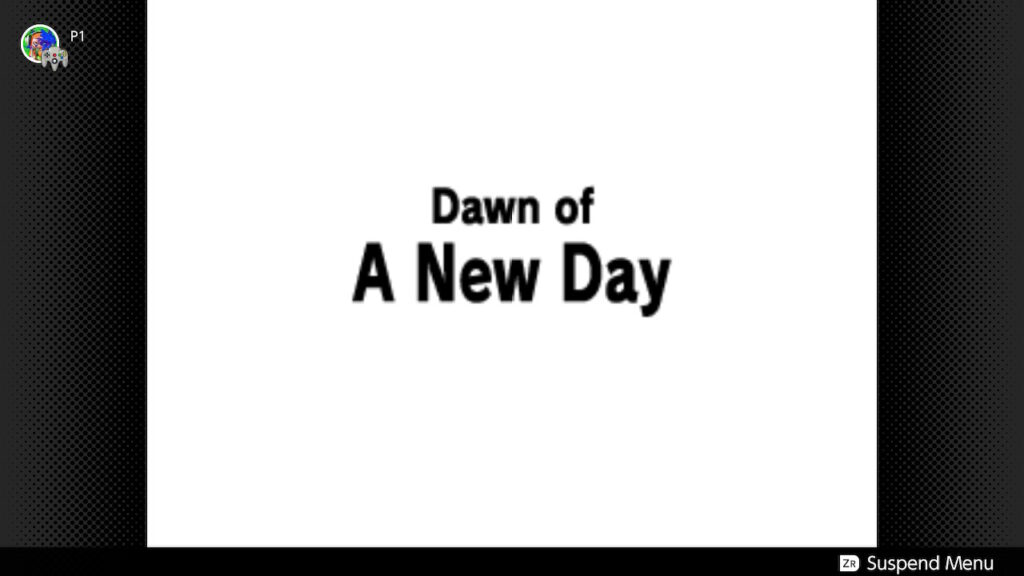
Highlights and Lowlights
I created this section starting with Ocarina of Time to talk more in-depth about what I thought worked and what I thought didn’t, so that the other sections wouldn’t get bogged down. With Majora’s Mask, it’s going to be pretty short.
The Lowlights were the minigames. I did not like the shooting galleries. I did not like the Honey and Darling games. I did not like the Deku playground. I keenly felt the age of the controls, and found them incredibly frustrating. I did not have fun while I was playing them. They almost made me abandon 100% completion. I would not have beaten the Town and Swamp Shooting Galleries had I not abused the Switch’s save states.
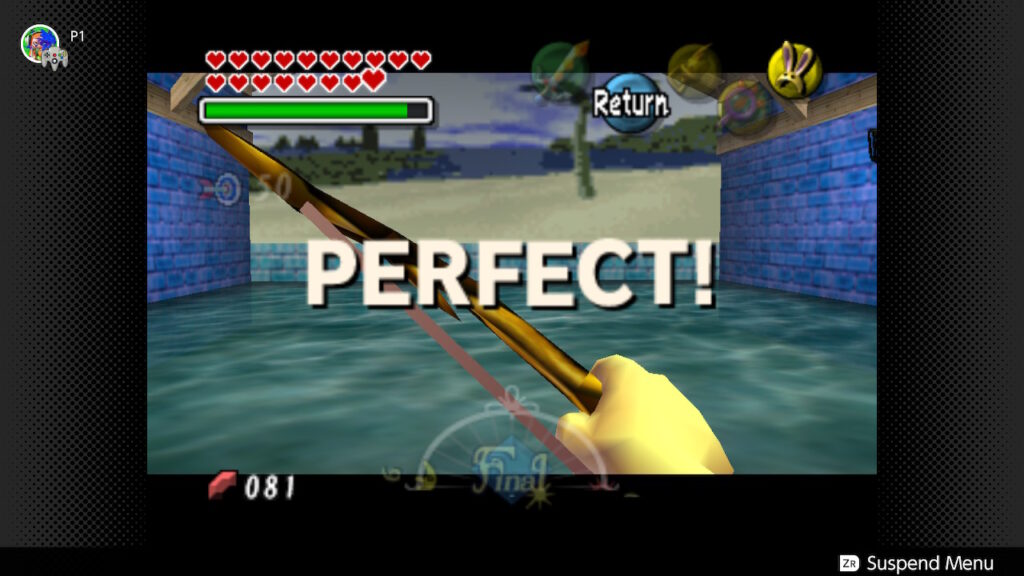
The highlights were literally everything else. With every new quest, every new dungeon, every new cycle, every failure, every success, I discovered something new to appreciate about the game, from the color scheme to a bit of dialog to environmental details to the game design. What an incredible experience from beginning to end.
The Verdict
Going into Majora’s Mask, I was worried I wouldn’t love it as much as I remembered loving it, especially since I had set the bar extremely high. At one point I had considered it my favorite game. Had other games surpassed it at this point? I was worried I’d be let down by my memory, especially considering I’d gained such a strong new appreciation for Link’s Awakening.
I’m pleased to announce that there was no reason to worry. Majora’s Mask is an amazing game, one that I would even go as far as to call flawless. While the world of Termina is a somewhat small one, the game is so densely packed that I feel like I’m constantly discovering new details, like how Cremia has a crush on Kafei (who’s about to marry her best friend Anju), or the little cow figures all around town whose heads bob when tremors hit, or how each area functions as a tutorial to introduce you to new tools or mechanics, or how the game is designed to always bring you back to Clock Town to see the comings and goings of its residents and become intimately familiar with their daily lives.
This is a game I could play over and over and still discover new things. I could spend an entire cycle following a single character, watching how the ever-increasing threat of the moon affects them. I could put on a mask and talk to everyone at different parts of each day. I could perfect my ability to play through the game and challenge myself to make every cycle as efficient as possible, to make every second count. If I could choose just one game to play for the rest of my life, it would be this one.
I don’t love Majora’s Mask so much as I’m in love with Majora’s Mask. It had a profound impact on me when I first played it, and it’s had an equally if not more profound impact on me now. Going into this playthrough, I thought it might be my favorite game. Coming out of it, I know.
I don’t think it should be any surprise where I place this one in my rankings.
- Majora’s Mask
- Link’s Awakening
- The Legend of Zelda (NES)
- Ocarina of Time
- A Link to the Past
- Zelda II: The Adventure of Link
Next up, I’ll be playing through the Oracle games. Rather than combining the two into one, as most do, I want to review them separately, starting with Oracle of Seasons and then Oracle of Ages. And let me tell you, I’m really excited for these two for one major reason: these were my very first Zelda games.
